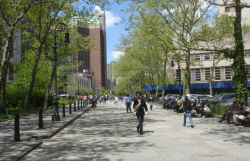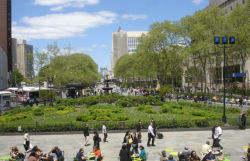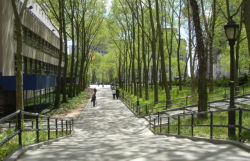Columbus Park
View all monuments in NYC Parks, as well as temporary public art installations on our NYC Public Art Map and Guide.
Henry Ward Beecher Monument
| Artist: | John Quincy Adams Ward |
| Dedicated: | June 24, 1891 |
| Location: | Cadman Plaza near Johnson Street |
Artwork History
Dedicated in 1891, this striking bronze figural group by sculptor John Quincy Adams Ward (1830–1910) honors the esteemed clergyman, abolitionist and orator Henry Ward Beecher (1813–1887).
Beecher was born on June 13, 1813 in Litchfield, Connecticut, and was the son of a well-known Presbyterian minister, Lyman Beecher (1775–1863). Among Henry Ward’s ten siblings was his sister Harriet Beecher Stowe (1811–1896), author of the classic anti-slavery novel, Uncle Tom’s Cabin (first published as a serial in 1851–52).
Beecher studied at Boston Latin School, graduated from Amherst College in 1834, and then studied at Lane Theological Seminary in Cincinnati, Ohio, where his father was director. In 1837 he was licensed as a preacher, and in 1839 became pastor of the Second Presbyterian Church of Indianapolis, a position he held eight years.
In 1847 Beecher took charge of the newly formed Plymouth Congregational Church in Brooklyn Heights. The church and congregation were said to be the largest in the United States, with seating capacity of 3,000 people. Beecher was an inspirational spiritual leader, and an outspoken and eloquent commentator on issues of the day, opposing slavery and supporting women’s suffrage, and through his sermons, lectures and writings attained broad influence on popular opinion.
Among Beecher’s extensive writings were Seven Lectures to Young Men (1844) and Evolution and Religion (1885). For 20 years he was an editorial contributor to the publication known as the Independent, and was its editor from 1861 to 1863. Late in Beecher’s career, his reputation was tarnished by charges of adultery brought in 1874, but the charismatic preacher was acquitted of all charges in a civil suit in 1875. He died on March 8, 1887.
Later referred to as “the Dean of American Sculptors,” Ward contributed nine sculptures to the parks of New York, among them Horace Greeley (1890) now in City Hall Park, Alexander Holley (1888) in Washington Square Park, William Earl Dodge (1885), now in Bryant Park, Roscoe Conkling (1893) in Madison Square Park, and The Indian Hunter (1869), William Shakespeare (1872), The Pilgrim (1885), and the Seventh Regiment Memorial (1874) in Central Park. He was chosen to make Beecher’s death mask, and then selected by the memorial committee to sculpt his full-scale bronze effigy.
The piece places the cloaked Beecher atop a lavish granite pedestal designed by architect Richard Morris Hunt (1828–1895). Attached to the base on one side is the figure of an African-American girl placing a palm branch at his feet, and on the other side a boy assists a girl laying a garland. Considered a full flowering of Ward’s artistic expression, Beecher is depicted in a pensive manner, and the figures beside the base symbolize his devotion to children and his support of abolitionism. Though there were repeated attempts to place the statue in Prospect Park, it was installed instead in front of Brooklyn Borough Hall, and dedicated before 15,000 spectators on June 24, 1891. In 1940 it was relocated and restored, and in 1960 it was relocated again to its current location at the north end of Columbus Park. For comparison, one may view another depiction in bronze, by Mount Rushmore’s sculptor, Gutzon Borglum (1867–1941), placed in 1914 in the courtyard of the Plymouth Church on Orange Street.
In 1987 this statue was conserved through the Adopt-A-Monument Program, a joint project of the Municipal Art Society, New York City Parks & Recreation, and the New York City Art Commission.
Artwork Details
| Description: | Standing figure (heroic scale) with integral plinth on pedestal with two steps, a standing female figure beside pedestal proper right and two child figures beside pedestal proper left |
| Architect: | Richard Morris Hunt |
| Materials: | Figures--bronze; Pedestal--Barre granite (polished) |
| Dimensions: | Beecher figure H: 7'6"; Pedestal H: 7' W: 10' D: 8'5" |
| Foundry: | Bonnard Bronze Co |
| Donor: | Public subscription |
| Cast: | May 10, 1890 |
Inscription
HENRY WARD BEECHER / 1813-1887 THE GRATEFUL GIFT / OF MULTITUDES OF / ALL CLASSES CREEDS / AND CONDITIONS / AT HOME AND ABROAD / TO HONOR THE GREAT / APOSTLE OF THE / BROTHERHOOD OF MAN.Please note, the NAME field includes a primary designation as well as alternate namingsoften in common or popular usage. The DEDICATED field refers to the most recent dedication, most often, butnot necessarily the original dedication date. If the monument did not have a formal dedication, the yearlisted reflects the date of installation.
For more information, please contact Art & Antiquities at (212) 360-8163.
Check out your park's Vital Signs
Clean & Safe
Green & Resilient
Empowered & Engaged Users
Share your feedback or learn more about how this park is part of a
Vital Park System




